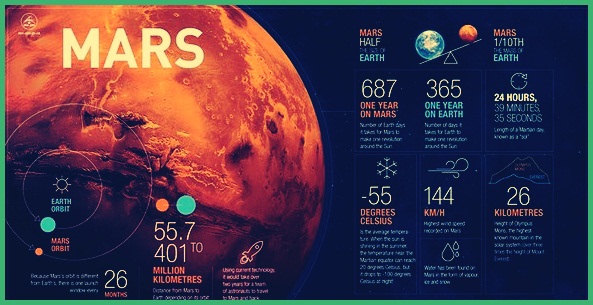Planet Mars
Planet Mars is the 4th closest planet from the sun. Just enter the name of the Viral Museum Bokeh Telegram application “Mars” taken from the name of the Roman god of war. He is Military God the first to be worshiped by the Roman Legion. For more details, see the Explanation of the Planet Mars Paper Material, includes Definition, Natural satellite, Characteristics, Structure, and the History of Planet Mars below.
Table of Contents
Definition of Planet Mars

Mars is the 4th closest planet from the Sun. Just enter the name of the Viral Museum Bokeh Telegram application “Mars” taken from the name of the Roman god of war. He is Military God the first to be worshiped by the Roman Legion.
The planet has another nickname, namely the Red Planet / Red Planet because it has a reddish color when viewed from a distance..
The color is caused by the presence of iron (III) oxides on the surface of the planet Mars. This planet has an estimated diameter of 6.780 km.
The ratio of the mass of Mars to that of Earth is 11:110. This planet has a distance from the Sun which is approx 228.000.000 km.
The time it takes for the Red Planet to revolve around the sun is approx 687 day.
Planet Mars originally had the same temperature and humidity and also the same time as Planet Earth which allowed living things to live on this planet.
| Summary Info Geogarafi Mars |
| 1. Distance from the Sun : 227,9 million km |
| 2. Equatorial rotation speed : 868,22 km/hour |
| 3. The period of rotation of the stars : 1,025 957 day; 24j 37m 22d |
| 4. Alternative name : Mars, Anggaraka 2. |
| 5. Known satellites : 2 |
| 6. Month: Phobos, Deimos |
Read Also : Planet Pluto
Mars . Natural Satellite
The planet Mars has two natural satellites, namely Phobos and Deimos, The explanation is as follows: :
1. Phobos Satellite
Phobos Satellite, This satellite orbits Mars within a radius of 6.000 km. Uniquely, According to experts, no other natural satellite can orbit a planet this close.
It is suspected that the Phobos satellite will hit Mars after 50 million years to come, This allegation arises because the planet Mars is every 100 year Phobos satellite approaches Mars at a distance of 1,8 m.
| Phobos . Satellite Overview |
| 1. Radius rata-rata : 11,267 km |
| 2. Distance to Earth : 77,79 million km |
| 3. Gravity : 0,0057 m/s² |
| 4. Period orbit : 8 jam |
| 5. Found : 17 August 1877 |
| 6. Age : 4,503 billion years |
2. Deimos satellite
The Deimos satellite is a smaller Mars satellite than the Phobos satellite, and this satellite only has a diameter of about 9-11 Km.
The orbit or orbit of the Deimos satellite is approx 20.000 km and tends to be stable, does not approach Mars which means it is not like the satellite Phobos.
Deimos orbits or orbits Mars with a period 30 jam, In addition, this satellite also has a flatter surface when compared to Phobos.
| Deimos . Satellite Overview |
| 1. Radius rata-rata: 11,267 km |
| 2. Surface area: 1548.3 km2 |
| 3. Gravity: 0,0057 m/s² |
| 4. Average temperature : ≈ 233 |
| 5. Average orbital speed: 2.138 km/s |
| 6. Rotation period: Tidal locking |
Characteristics of the Planet Mars
The planet Mars is not shrouded by clouds so this planet can be seen and found a number of stains.
After circulating and returning to its original position, various colored parts of the surface of Mars will be seen.
From these stains it can also be seen that the rotation of Mars is 24 jam 37 minute 23 seconds.
There are several astronomers who have succeeded in researching Mars or the Red Planet, including:
Giovanni Schiaparelli, he is an astronomer from Italy. In 1877, he has done a thorough research of Mars.
Giovani has discovered the black fields (Noda) found on the surface of Mars with black lines called canalo or canals (Canal)
Which canalo / canals are many, and has a length of up to hundreds of kilometers, but the width is only 2-3 kilometer.
Giovani's research was also initially confirmed by Lowel who was an astronomer (America) which he built a stargazing observatory “Lowel Observatory” to investigate Mars.
According to Lowell, on Mars there are Martian Canals or canals of Mars that flow water in spring from north to south and in autumn from south to north.
After careful observation with binoculars,, at first that looks like a long line, and only the dots that are in large numbers.
With small binoculars, the points coincide to form a line. So the conclusion, Giovanni Schiaparelli has made a mistake in seeing or misinterpreting.
Back to the characteristics of the planet mars, We have summarized the general characteristics of the planet Mars in the following table: :
| No | Characteristics of Mars |
| 1 | Diameter : 6.794 km |
| 2 | Average distance from the Sun : 227,9 million km |
| 3 | Rotation time : 24 jam 37 minute 23 seconds |
| 4 | During the revolution : 687 day |
| 5 | Has temperature -65 degrees Celsius |
| 6 | Have 2 Satellite |
| 7 | No ring |
| 8 | Composed of very thin carbon dioxide |
Structure Planet Mars
Mars has a structure that is divided into two types, namely the inner structure and the outer structure. Here is the full explanation :
1. The Outer Structure of the Planet Mars
The distance of Mars from the Sun is further compared to the distance of the Earth from the Sun.
The atmosphere or gas layer on Planet Mars is different from the gas layer on Earth. Where is this planet found small amounts of methane. This methane content could mark life on Mars
2. Surface of Planet Mars
Planet Mars has valleys, dry river, the mountains, and the ice layer on the surface.
In addition, Mars also has many craters and volcanoes, big and deep gorges, and also the surface grooves that have been drained by water.
3. Climate & Atmosfer Planet Mars
The atmosphere on Mars is thinner than that on Earth with a pressure of approx 1/150 Earth's atmosphere.
Mars' atmosphere is made up of 95,3% carbon dioxide, 2,7% Nitrogen, as well as 1,6% Argon, and other gases such as carbon monoxide, oxygen, add a little water vapor.
Geological History of Planet Mars
A brief history of the planet mars, which is actually divided into several periods, but below is 3 prime prime time, which is as follows :
- Noachian times : The oldest surface formation of the Planet Mars, that is, between 3,5 billion- 4,5 billion years ago. On the surface of the Noachis period which is filled with impact craters that have very large diameters.
- Hesperian time : 3,5 billion -2.9–3,3 billion years ago. Which time is marked by the formation of lava plains.
- Amazonian times : 2,9 – 3,3 billion years ago to the present Olympus Mons (volcano) formed in this period, and so are other lava flows.
The planet Mars has two natural satellites, namely Phobos and Deimos.
1. Diameter : 6.794 km
2. Average distance from the Sun : 227,9 million km
3. Rotation time : 24 jam 37 minute
4. During the revolution : 687 day
5. Temperature -65 degrees Celsius
6. Number of satellites 2
7. Don't have a ring
8. Composed of very thin carbon dioxide
Mars is the 4th closest planet to the sun. Just enter the name of the Viral Museum Bokeh Telegram application “Mars” taken from the name of the Roman god of war.
He is Military God the first to be worshiped by the Roman Legion.
That's our explanation of the Complete Mars Planet Material. Don't forget to always visit our website so that you can get a lot of knowledge. Thank you.
The post Planet Mars appeared first on YukSinau.co.id.
